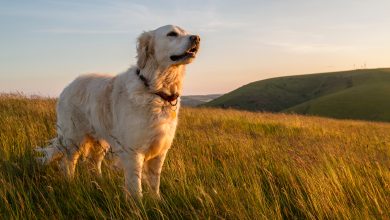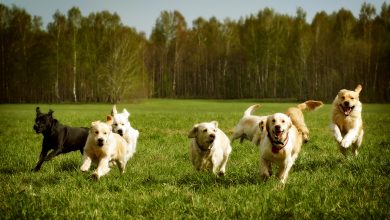Discover the Secrets of African Wild Dog Packs

African wild dogs, also known as painted dogs or Cape hunting dogs, are fascinating and highly social animals that roam the savannas and woodlands of sub-Saharan Africa. With their striking coats of black, yellow, and white, they are easily recognizable among other predators in the region. But there is more to these creatures than just their appearance.
Understanding the behavior of African wild dogs is crucial for their conservation and management. In this blog, we will delve into the world of these unique animals and uncover some of their secrets.
2. Characteristics of African Wild Dogs
African wild dogs have a slender build with long legs and big rounded ears. They have a mottled coat pattern that serves as excellent camouflage in their natural habitats. Each individual dog’s coat is unique, with a mix of black, yellow, and white patches that add to their striking appearance. Typically found in the savannas, open woodlands, and grasslands of sub-Saharan Africa, these dogs are highly adaptable to different environments.
Their diet mainly consists of medium-sized ungulates such as impalas and gazelles. They employ exceptional teamwork and strategic planning during hunts, often encircling and exhausting their prey to ensure a successful capture. Their cooperative hunting methods and efficient communication are key to their survival in the wild.
3. Pack Structure and Social Dynamics
The pack structure of African wild dogs is a prime example of intricate social dynamics and hierarchical organization. Central to the pack is the alpha pair, typically the dominant male and female, who play crucial roles in leadership and reproduction. The alpha pair is responsible for making important decisions, such as when and where to hunt, and holds the exclusive right to breed, ensuring the stability and continuity of the pack.
Beneath the alpha pair, the pack exhibits a complex social hierarchy, with individual roles and responsibilities shared among members. Social bonds and cooperation are the glue that holds the pack together, with individuals displaying remarkable levels of teamwork, care, and communication. This strong sense of affiliation and collective effort is especially evident during hunting excursions and in the nurturing of young pups, where the entire pack works in unison to support the group’s survival.
4. Hunting and Feeding Strategies
African wild dogs are renowned for their exceptional coordination and teamwork during hunts, which greatly enhances their success rates. These agile predators utilize sophisticated techniques and strategies to secure their prey, often relying on speed, endurance, and strategic planning. Hunts typically begin with a pack member identifying a target, followed by a coordinated effort to encircle and isolate the prey.
The dogs then take turns chasing the prey in relays, exhausting it until it can no longer flee. This high level of cooperation extends to the feeding process, where a clear hierarchy dictates the order in which pack members eat.
The alpha pair generally feeds first, followed by the rest of the pack in descending order of rank. Food sharing is a well-organized affair, ensuring that even the youngest and weakest members receive nourishment. This equitable distribution of food reinforces social bonds and ensures the stability and health of the pack.
5. Communication within the Pack
Communication within a pack of African wild dogs is both complex and highly sophisticated, involving a range of vocalizations, body language, visual signals, and scent marking. Vocalizations are a key aspect of their communication, with different sounds conveying various messages. For instance, short barks often serve as alarms, while a series of high-pitched twittering calls are used to assemble the pack for hunting or moving to a new location.
Body language and visual signals are equally important, with tail positions, ear postures, and facial expressions all providing cues about an individual’s intentions or emotional state. Submissive gestures, such as crouching low or tail wagging, help maintain social harmony and reduce conflicts within the pack. Additionally, scent marking plays a crucial role in territory delineation and status signaling.
Pack members frequently use urine, feces, and scent glands to mark their territory and communicate reproductive status. This multi-faceted communication system ensures effective coordination and cooperation, which are vital for the survival and success of the pack.
6. Reproduction and Raising Offspring
Mating behavior among African wild dogs is typically restricted to the alpha pair, with breeding occurring once a year, often around the late rainy season to early dry season. This timing ensures that pups are born when prey is most abundant, increasing their chances of survival. Once the alpha female gives birth, the entire pack plays an essential role in raising the young.
Pups are nursed by the mother and weaned onto solid food regurgitated by other pack members. The social structure of the pack ensures that the young are well-protected and nourished, with babysitter roles often rotated among the adults.
Despite these concerted efforts, the survival rate of pups in the wild can be low due to predation and disease. However, those that do survive grow rapidly and start joining hunting expeditions as early as 3-4 months old, gradually honing their skills to become proficient hunters alongside their pack.
7. Challenges and Conservation Efforts
African wild dogs face numerous threats that have led to their classification as an endangered species. Habitat loss due to human encroachment and agricultural expansion has significantly reduced their living space, while disease outbreaks, particularly canine distemper and rabies, have devastated populations.
Poaching and human-wildlife conflict further compound these challenges, often leading to the direct killing of these animals. Despite these daunting obstacles, several conservation initiatives have yielded positive outcomes. Efforts such as habitat restoration, anti-poaching patrols, and disease management programs have helped stabilize certain wild dog populations.
Moreover, breeding programs and the establishment of protected areas have provided safe havens for these remarkable creatures. Individuals can also play a role in their preservation by supporting wildlife organizations, promoting awareness about the species’ plight, and advocating for policies that protect natural habitats. Together, these combined efforts bring hope for the enduring survival of African wild dogs in the wild.
8. Conclusion
In conclusion, the intricate social structures and remarkable behaviors of African wild dog packs provide a fascinating glimpse into the complexities of wildlife coordination and cooperation. We explored how the alpha pair leads the pack in leadership and reproduction, maintains social order during hunting and feeding, and ensures the nurturing and protection of offspring. Communication within the pack, through vocalizations, body language, and scent marking, further highlights the sophisticated nature of these animals.
However, African wild dogs face numerous challenges that threaten their survival. Habitat destruction, disease, poaching, and human-wildlife conflict have all contributed to their endangered status. Conservation efforts, including habitat restoration, anti-poaching measures, and breeding programs, have shown promising results in stabilizing some populations, but there is still much work to be done.
Preserving African wild dogs is crucial for maintaining biodiversity and ecosystem health. Their role as apex predators helps balance prey populations, contributing to the overall stability of their environment. By supporting wildlife conservation initiatives, raising awareness about the plight of African wild dogs, and advocating for protective policies, we can all contribute to their survival.
We encourage you to delve deeper into the world of African wild dogs and join the movement to protect these incredible creatures. Supporting wildlife organizations, spreading awareness, and participating in conservation efforts can make a significant impact. Together, we can ensure that future generations will continue to be inspired by the extraordinary lives of African wild dogs.
9. Additional Resources
To further explore the fascinating world of African wild dog packs, we have compiled a list of valuable resources. These include links to documentaries, informative articles, organizations dedicated to their conservation, and reading recommendations for enthusiasts.
Documentaries
- “The Pack: African Wild Dogs” – Watch on National Geographic
- This documentary provides an in-depth look at the lives of African wild dogs, their social structures, and the challenges they face in the wild.
- “African Wild Dog: The Hunt” – View on BBC Earth
- Follow a pack of African wild dogs on their hunting expeditions and witness the remarkable coordination and teamwork that ensure their survival.
- “The Social Lives of African Wild Dogs” – Read on Scientific American
- This article delves into the complexity of wild dog society, exploring their communication methods, pack dynamics, and survival strategies.
- “Conservation Efforts for African Wild Dogs” – Explore on World Wildlife Fund
- Learn about the current conservation efforts and the role different organizations play in the preservation of these endangered animals.
- Painted Dog Conservation
- Visit Website
- This organization is dedicated to the conservation of African wild dogs through research, community engagement, and direct action.
- Endangered Wildlife Trust
- Visit Website
- A conservation body actively involved in various initiatives to protect African wild dogs, including habitat restoration and anti-poaching measures.
- “The African Wild Dog: Behavior, Ecology, and Conservation” by Scott Creel and Nancy Marusha Creel
- A comprehensive book that offers insights into the behavior, ecology, and conservation of African wild dogs. Ideal for those seeking an in-depth understanding of these animals.
- “Candid Creatures: How Camera Traps Reveal the Mysteries of Nature” by Roland Kays
- This book includes captivating images and stories from camera traps, featuring African wild dogs among other wildlife, unraveling their secret lives.




